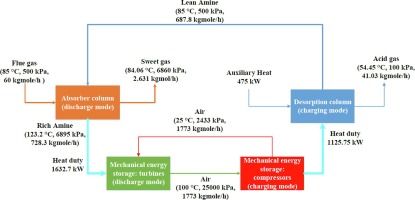当前位置:
X-MOL 学术
›
Energy Convers. Manag.
›
论文详情
Our official English website, www.x-mol.net, welcomes your
feedback! (Note: you will need to create a separate account there.)
Introducing a hybrid mechanical – Chemical energy storage system: Process development and energy/exergy analysis
Energy Conversion and Management ( IF 9.9 ) Pub Date : 2020-05-01 , DOI: 10.1016/j.enconman.2020.112784 Mehdi Mehrpooya , Pouria Pakzad
Energy Conversion and Management ( IF 9.9 ) Pub Date : 2020-05-01 , DOI: 10.1016/j.enconman.2020.112784 Mehdi Mehrpooya , Pouria Pakzad

|
Abstract The purpose of this study is to develop and introduce a novel hybrid energy storage system composed of compressed air energy storage cycle as mechanical storage and amine assisted CO2 capture cycle as chemical energy storage. The novelty of this study is to increase the efficiency of mechanical storage cycle by using chemical storage and in this way, the heat released and absorbed by the chemical cycle is used. Two methods of first and second law examination are used to study proposed system. In particular, this energy storage system that stores energy by simultaneously compressing a gas to a higher enthalpy state and recovering the heat of compression by driving a somewhat reversible chemical reaction. The heat energy in the chemical reaction is then recovered while the gas is expanding to a lower enthalpy state. Reboiler of the desorption column requires 1600 kW heat and the power produced by the turbines and consumed by the compressors is 2400 kW and 3884 kW, respectively. Also, the flow rate of the mechanical storage working fluid is 1773 kgmole/h and the storage temperature and pressure are 100 °C and 25 MPa, respectively. In this study, Aspen HYSYS and MATLAB software were used simultaneously for simulation and the results show that round-trip efficiency and exergy efficiency are 51.45% and 72.16%, respectively. Finally, the effect of the various parameters such as fluids inlet temperature to absorption column, CO2 loading and storage temperature on round trip efficiency and exergy efficiency are investigated.
中文翻译:

引入混合机械 - 化学储能系统:工艺开发和能量/火用分析
摘要 本研究的目的是开发和引入一种新型混合储能系统,由压缩空气储能循环作为机械储能和胺辅助二氧化碳捕获循环作为化学储能。本研究的新颖之处在于通过使用化学存储来提高机械存储循环的效率,从而利用化学循环释放和吸收的热量。使用第一法和第二法考试两种方法来研究提议的系统。特别是,这种能量存储系统通过同时将气体压缩到更高的焓状态并通过驱动某种可逆的化学反应来回收压缩热来存储能量。然后在气体膨胀到较低焓状态时回收化学反应中的热能。解吸塔的再沸器需要1600 kW的热量,涡轮产生的功率和压缩机消耗的功率分别为2400 kW和3884 kW。此外,机械储存工作液的流速为1773 kgmole/h,储存温度和压力分别为100°C和25 MPa。本研究同时使用 Aspen HYSYS 和 MATLAB 软件进行仿真,结果表明往返效率和火用效率分别为 51.45% 和 72.16%。最后,研究了吸收塔的流体入口温度、CO2 加载和储存温度等各种参数对往返效率和火用效率的影响。此外,机械储存工作液的流速为1773 kgmole/h,储存温度和压力分别为100°C和25 MPa。本研究同时使用 Aspen HYSYS 和 MATLAB 软件进行仿真,结果表明往返效率和火用效率分别为 51.45% 和 72.16%。最后,研究了吸收塔的流体入口温度、CO2 负载和储存温度等各种参数对往返效率和火用效率的影响。此外,机械储存工作液的流速为1773 kgmole/h,储存温度和压力分别为100°C和25 MPa。本研究同时使用 Aspen HYSYS 和 MATLAB 软件进行仿真,结果表明往返效率和火用效率分别为 51.45% 和 72.16%。最后,研究了吸收塔的流体入口温度、CO2 负载和储存温度等各种参数对往返效率和火用效率的影响。同时使用 Aspen HYSYS 和 MATLAB 软件进行仿真,结果表明往返效率和火用效率分别为 51.45% 和 72.16%。最后,研究了吸收塔的流体入口温度、CO2 负载和储存温度等各种参数对往返效率和火用效率的影响。同时使用 Aspen HYSYS 和 MATLAB 软件进行仿真,结果表明,往返效率和火用效率分别为 51.45% 和 72.16%。最后,研究了吸收塔的流体入口温度、CO2 负载和储存温度等各种参数对往返效率和火用效率的影响。
更新日期:2020-05-01
中文翻译:

引入混合机械 - 化学储能系统:工艺开发和能量/火用分析
摘要 本研究的目的是开发和引入一种新型混合储能系统,由压缩空气储能循环作为机械储能和胺辅助二氧化碳捕获循环作为化学储能。本研究的新颖之处在于通过使用化学存储来提高机械存储循环的效率,从而利用化学循环释放和吸收的热量。使用第一法和第二法考试两种方法来研究提议的系统。特别是,这种能量存储系统通过同时将气体压缩到更高的焓状态并通过驱动某种可逆的化学反应来回收压缩热来存储能量。然后在气体膨胀到较低焓状态时回收化学反应中的热能。解吸塔的再沸器需要1600 kW的热量,涡轮产生的功率和压缩机消耗的功率分别为2400 kW和3884 kW。此外,机械储存工作液的流速为1773 kgmole/h,储存温度和压力分别为100°C和25 MPa。本研究同时使用 Aspen HYSYS 和 MATLAB 软件进行仿真,结果表明往返效率和火用效率分别为 51.45% 和 72.16%。最后,研究了吸收塔的流体入口温度、CO2 加载和储存温度等各种参数对往返效率和火用效率的影响。此外,机械储存工作液的流速为1773 kgmole/h,储存温度和压力分别为100°C和25 MPa。本研究同时使用 Aspen HYSYS 和 MATLAB 软件进行仿真,结果表明往返效率和火用效率分别为 51.45% 和 72.16%。最后,研究了吸收塔的流体入口温度、CO2 负载和储存温度等各种参数对往返效率和火用效率的影响。此外,机械储存工作液的流速为1773 kgmole/h,储存温度和压力分别为100°C和25 MPa。本研究同时使用 Aspen HYSYS 和 MATLAB 软件进行仿真,结果表明往返效率和火用效率分别为 51.45% 和 72.16%。最后,研究了吸收塔的流体入口温度、CO2 负载和储存温度等各种参数对往返效率和火用效率的影响。同时使用 Aspen HYSYS 和 MATLAB 软件进行仿真,结果表明往返效率和火用效率分别为 51.45% 和 72.16%。最后,研究了吸收塔的流体入口温度、CO2 负载和储存温度等各种参数对往返效率和火用效率的影响。同时使用 Aspen HYSYS 和 MATLAB 软件进行仿真,结果表明,往返效率和火用效率分别为 51.45% 和 72.16%。最后,研究了吸收塔的流体入口温度、CO2 负载和储存温度等各种参数对往返效率和火用效率的影响。











































 京公网安备 11010802027423号
京公网安备 11010802027423号